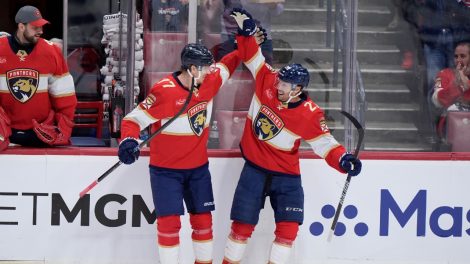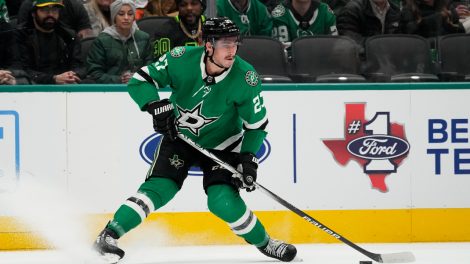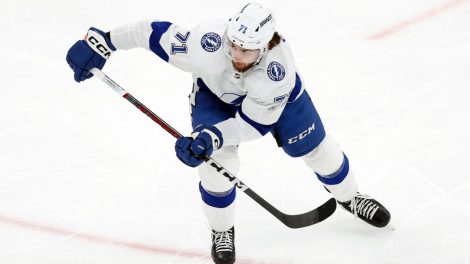Jack Eichel is on track to be the most productive NCAA prospect to make the jump to the NHL in recent memory. To find an NHL prospect who had similar numbers to Eichel in the NCAA, you need to go back to Paul Kariya, who posted 124 points in 51 games for Maine University in the mid-90’s.
It’s challenging to project what type of results we should expect from Eichel and other NCAA prospects such as Noah Hanfin or Dylan Larkin when they enter the NHL.
Prior to the NHL draft we looked at what sort of production we can expect out of Connor McDavid and thanks to the plethora of CHL prospects who made the leap directly from the draft to the NHL we can project reasonably well. There are more layers involved in projecting NCAA prospects due to a variety of factors.
Other top NCAA prospects have made the leap to the NHL, but the number of them who leave after only one year of college hockey is quite low since signing a professional contract immediately voids NCAA eligibility.
In addition, it is fairly common for NCAA prospects to go through at least a partial season of AHL hockey once they do turn professional, since they aren’t encumbered by the CHL-NHL transfer agreement.
To account for this we can refer to some old work around NHL league equivalencies done by Gabriel Desjardins. If we equate each AHL point a younger prospect produces prior to (or in) their NHL rookie season as being worth approximately 66 percent of an NHL point, we can factor their AHL production into how they are performing overall at the start of their NHL career.
In an effort to project the performance of NCAA prospects, we then graph NCAA points per game versus our new combination of AHL points (at the 66% discount) + NHL Rookie points per game. This gives us the following graph:
The three outlier players at the top of the chart are (in descending order of point production) Paul Stastny, Jonathan Toews and Drew Stafford. Kariya is the player on the extreme right end.
In order to assess what we can expect from NCAA prospects making the leap to the AHL/NHL we then just need to apply the shown logarithmic formula. Here is what we would project for the 16 NCAA skaters who have signed professional contracts with NHL clubs since the end of last season:
While expectations for Eichel in Buffalo are sky high with many suggesting he could reach a point per game, past results for NCAA prospects making the jump to the NHL would suggest he is more likely to come in as a 0.68 point per game player.
That may not seem special, but considering he’s likely to see relatively sheltered second-line minutes behind Ryan O’Reilly that level of production is actually right in line with a top end second-liner, or fringe first-line player.
Just for comparison, consider that last year these forwards produced 0.68 points per game: James van Riemsdyk, Marian Gaborik, Patrice Bergeron, Jonathan Huberdeau and Tomas Tatar. Ironically, Ryan O’Reilly actually produced 0.67 points per game in 2014-15 with the Avalanche, as did Colorado’s other top center Matt Duchene, so Eichel’s projected rookie scoring rate is nothing to scoff at.
A 0.68 points per game pace would rank tied for the 20th-best rookie production rate for a skater 20 years old or younger since the 2004-05 lockout, alongside the aforementioned Duchene and Ryan Getzlaf.
Dylan Larkin’s projected scoring rate of 0.58 points per game puts him in solid second-liner territory, right around the production we saw from rookie sensation David Pastrnak of the Bruins last season (0.59 ppg) and some other special names like Steven Stamkos and Alexander Radulov (both 0.58 ppg in their rookie seasons).
On the blueline it doesn’t look like Noah Hanfin will be the big story out of the college ranks. The Minnesota Wild have every reason to be excited about former Minnesota Golden Gophers blueliner Mike Reilly. In addition to being a local hero, Reilly earned all kinds of honours in the NCAA and this past spring he won a bronze medal at the IIHF World Hockey Championship with team USA.
Reilly’s projected scoring rate of 0.36 points per game would put his rookie production alongside a veritable all-star team of offensively skilled rookie defenders: Dougie Hamilton (0.38 PPG), Hampus Lindholm (0.38 PPG), Olli Maata (0.37 PPG), Morgan Rielly (0.37 PPG), James Wisniewski (0.37 PPG), Shea Weber (0.36 PPG), Dennis Wideman (0.36 PPG), Ryan Ellis (0.34 PPG) and Cody Franson (0.34 PPG).
However the season shakes out, this season the Calder watch should take on a new level of intrigue as we wait to find out which of Eichel, McDavid, or some unexpected rival takes the crown for top young impact player. Now we just need training camps to get going and the race to begin.











